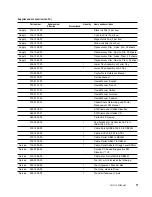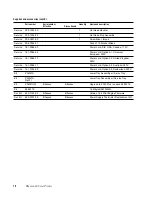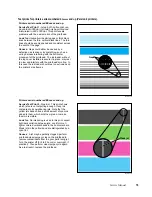
4
Phaser 340 Color Printer
Jet interlacing
BC
xxxxx
printers use a different method of laying ink onto the drum; they perform
a “four-jet interlace.” As the drum reaches the correct speed of 176 rpms, the
ink-jets begin to fire to deposit the image on the oiled portion of the drum. As the
jets fire, the printhead slews in the x-axis to complete the image on the drum.
When the ink image is about 80% complete, the paper-pick cycle begins.
For 300 dpi printing, each jet lays down 28 pixel columns. Each jet lays down one
pixel column for each drum rotation (28 revolutions total). Each jet travels
horizontally the distance of 112 pixels to lay down its 28 pixel columns within that
112 pixel-wide field. The 112 pixel-wide field of each jet overlaps the
112 pixel-wide field of six other jets; this is where interlacing occurs. To lay down
its 28 pixel columns, each jet follows this sequence:
1.
Print 1st column, step four columns to the right, print 2nd column, step
four columns to the right. Repeat until 7 columns are laid down.
2.
Step 2 additional columns to the right.
3.
Print the 8th column, step 4 columns to the right, print 9th column, step
4 columns to the right. Repeat until 7 columns are laid down (total of 14
so far).
4.
Step 1 additional column to the right.
5.
Print the 15th column, step 4 columns to the right, print the 16th
column, step 4 columns to the right. Repeat until another 7 columns are
laid down (21 total so far).
6.
Step 2 additional columns to the right.
7.
Print the 22nd column, step 4 columns to the right, print the 23rd
column, step 4 columns to the right. Repeat until the last 7 columns are
laid down for a total of 28 pixel columns.
The intermediate 2-step, 1-step and 2-step movement between the 7th and 8th
pixel columns, the 14th and 15th columns, and the 21st and 22nd columns,
respectively, allow the 28 pixels columns of each jet to properly interlace with the
28 pixel columns of the other jets it is combined with. A total of 2,432 columns,
each 3,134 dots tall, are laid down.
The advantage of this print method is that variability between jets is “averaged
out” by being interlaced with three other jets. As shown in the illustration, of the
28 pixel columns printed by any single jet, only two of its pixel columns are
actually ever adjacent. Usually they are separated by three other pixel columns
produced by other jets, hence the name
four-jet interlace
. Because of the 28 pixel
spacing between jets and the 112 pixel-wide field that each jet travels, the pixel
columns of any one jet actually interlaces with the pixel columns of six other jets,
although no more than four at any one time.
In reality, because of the fixed width of the printhead and inter-jet spacing, the
outermost jets cannot interlace completely with their adjacent jets. In this case, the
drum rotates for seven extra imaging rotations (14 if both end jets are needed) for
the printhead to reposition the end jets so they can fill-in the missing pixel columns
that cannot otherwise be interlaced.





































